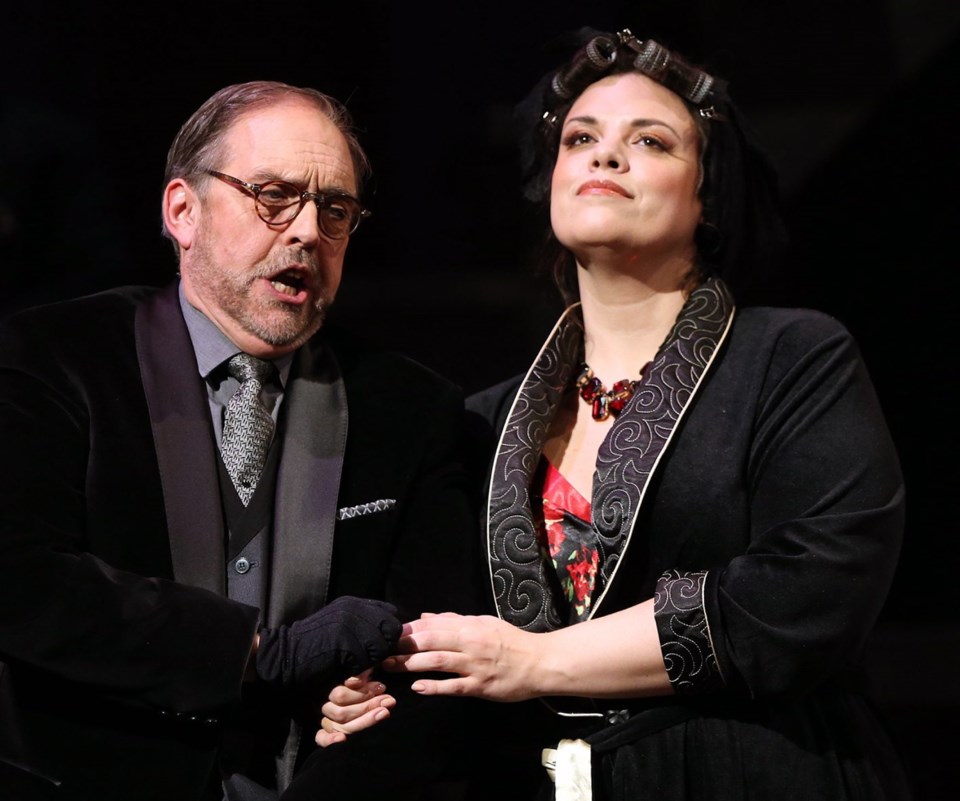REVIEW
What:Pacific Opera Victoria: Ariadne auf Naxos, by Richard Strauss
When/where: Feb. 15 and 21, 8 p.m.; Feb. 23, 2:30 p.m.; Royal Theatre; pre-performance lecture one hour before showtime
Tickets: $40 to $125; rmts.bc.ca, 250-386-6121; student rush tickets $15 at the door one hour before each performance, subject to availability
Richard Strauss conceded that he wrote operas with the biggest companies in mind, and pitied those poor provincial houses whose pit accommodated just 50 performers. Well, the Royal Theatre’s pit accommodates just 40, yet that didn’t stop Pacific Opera Victoria from mounting Strauss’s Daphne and Capriccio. Timothy Vernon, POV’s artistic director, loves Strauss’s music so much that he simply brought the mountain to Mohammed with those operas by reducing the orchestrations himself.
Only one Strauss opera actually calls for an orchestra small enough for the Royal: Ariadne auf Naxos, which requires three dozen players. POV first produced it in 1999; on Thursday — just a few months shy of Strauss’s 150th birthday — it opened a new production of Ariadne, to a heartening ovation.
The structure of Ariadne is unusual: a short Prologue followed by a one-act Opera. The Prologue depicts the backstage shenanigans of the creative team behind the Opera, which is a serious setting of a Greek myth — the Cretan princess Ariadne is abandoned on the island of Naxos by her lover but won over by the god Bacchus — into which the songs and dances of commedia dell’arte characters intrude. The curiously schizophrenic, serio-comic personality of the Opera is explained in the Prologue: A Viennese arts patron decides to entertain his guests with a serious opera about Ariadne followed by a burlesque; however, with time pressing, he demands that the two shows be performed simultaneously — and commotion ensues.
The novel Prologue-Opera structure, incidentally, was a byproduct of the work’s genesis. As first performed, in 1912, Ariadne auf Naxos was a one-act opera played as an epilogue to a performance of Molière’s play Le bourgeois gentilhomme, for which Strauss also wrote incidental music; the final version, with an explanatory Prologue replacing the play, followed in 1916. The result was a self-aware, often ironic and satirical opera-about-opera that was in some ways ahead of its time.
Strauss’s score — clever, intricate, boundlessly inventive — includes the driest recitative, the most impassioned and effusive lyricism, and every level of song in between, and the 18th-century setting gave him an excuse to exercise a knowing, witty neoclassicism. On Thursday, Vernon led the Victoria Symphony in an impeccable, stylish, deeply felt performance that made plain once again his profound affection for and commitment to Strauss.
Among the four lead singers (all making POV debuts) are three women with very distinct soprano voices, each one perfectly suited to her character. Suzanne Rigden, pert and personable as the worldly flirt Zerbinetta, has a gleaming, cleanly articulate coloratura sound, and she nails her huge, dazzlingly virtuosic recitative and aria, which ranges up to high E. Colleen Skull has the plush, robust tone and commanding presence befitting both incarnations of her character — “Primadonna” (as Strauss calls her) in the Prologue, Ariadne in the Opera. And mezzo Arminè Kassabian, singing with both beauty and strength, makes us love the ardent, idealistic young Composer (a trouser role).
Tenor Roger Honeywell, forcefully heroic as Bacchus, dominates the last part of the Opera, and there is consistently solid vocal work and appealing acting from the large supporting cast, with standouts including tenor Joseph Schnurr, as the flamboyant Dancing Master, and baritone John Brancy, as Harlekin.
Director Oriol Tomas has set his production in modern times, and while Ian Rye’s set for the Opera retains an ancient-Greek flavour, the Prologue has an amusingly inside-out, Noises Off look. Costume designer Sheila White, meanwhile, offers charmingly effective modern equivalents for stock commedia dell’arte looks.
Comic and dramatic elements alike are convincingly staged, but the pleasures of this production are above all musical: POV has done credit to a unique and heterogeneous and exquisitely wrought score.
